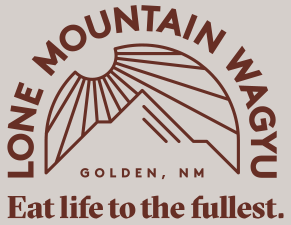Wagyu is a breed of Japanese cattle that, owing to some remarkable genetics, is renowned for its rich flavor and marbling. In fact the very word Wagyu translates literally to ‘Japanese Cow.’
Its most famous expression is Kobe Beef, a luxurious delicacy named for the capital city (Kobe) of the Hyogo Prefecture, where Wagyu are raised and slaughtered under strict guidelines.
So all Kobe is Wagyu, but not all Wagyu is Kobe. It’s that simple.
FYI: there is no such thing as American Kobe. It’s nonsense.
Now, Wagyu cattle have been exported and raised all over the world, most successfully in the USA and Australia. Often times, it’s crossbreed with other breeds of cattle (like Angus.) This creates a complicated and deceiving classification system. It also dilutes what makes Wagyu so special, because the less Wagyu genetics in an animal, the less rich and marbled it will be.
We don’t like that. We want our meat to be as rich and marbled as possible.
Obviously.
So at Lone Mountain Wagyu, our cattle are never crossbred. They are 100% Wagyu. Each animal is DNA-certified to show its direct lineage to its Japanese heritage.
Because it’s that heritage that gives Wagyu its superpowers. The most important of which is… marbling!
Marbling refers to the delicate lines of fat that curl and tendril through a steak. Marbling gives beef flavor. So it’s graded on how much Intramuscular Fat (IMF) it contains. The highest ranking of beef you can buy in the US is Prime. That’s around 10-12% IMF.
There’s nothing wrong with Prime, but Wagyu can do better.
It’s hard to put a number on how much better, but fortunately… we can.
At least three times better. Our Wagyu has an IMF between 28-40%.
And that fat isn’t just normal fat. Wagyu is full of Omega-3 and Omega-6 fatty acids, those same good monounsaturated fats you find in salmon. Wagyu’s fat also melts at a lower temperature, so you get a rich, silky texture that coats your mouth with every bite. (It’s also far better for you, as the ratio of HDL to LDL is far higher than in other beef.)
Make sense? Ok. Good. Here’s where it gets even more interesting.
There are several strains of Wagyu. The Japanese tradition is to breed those different strains to create an animal with the highest quality offspring. This takes time and patience and very, very careful record-keeping. If you ever want to go down a fascinating black hole of Wagyu lineage, just ask Bob to see his records.
One of the things we do is combine the Tajima strain (a Black Wagyu acclaimed for intense marbling) with Shimane or Fujiyoshi strains (also Black Wagyu known for their large size.) This creates a perfect animal that’s strong, healthy, and (most importantly) highly marbled.
And to make sure that we don’t waste the opportunity that Wagyu genetics and breeding has given us, we wet-age our meat. This concentrates all the flavor and creates an unreal, earthy supple mouthfeel that is just… well… decadent.
So that’s the science of it… but it’s not all about nature. Nurture plays a key role in raising Wagyu that delivers the goods. You can raise Wagyu cattle badly and have bad meat. We think you should raise it well. If you want to know how we do it, read on.







